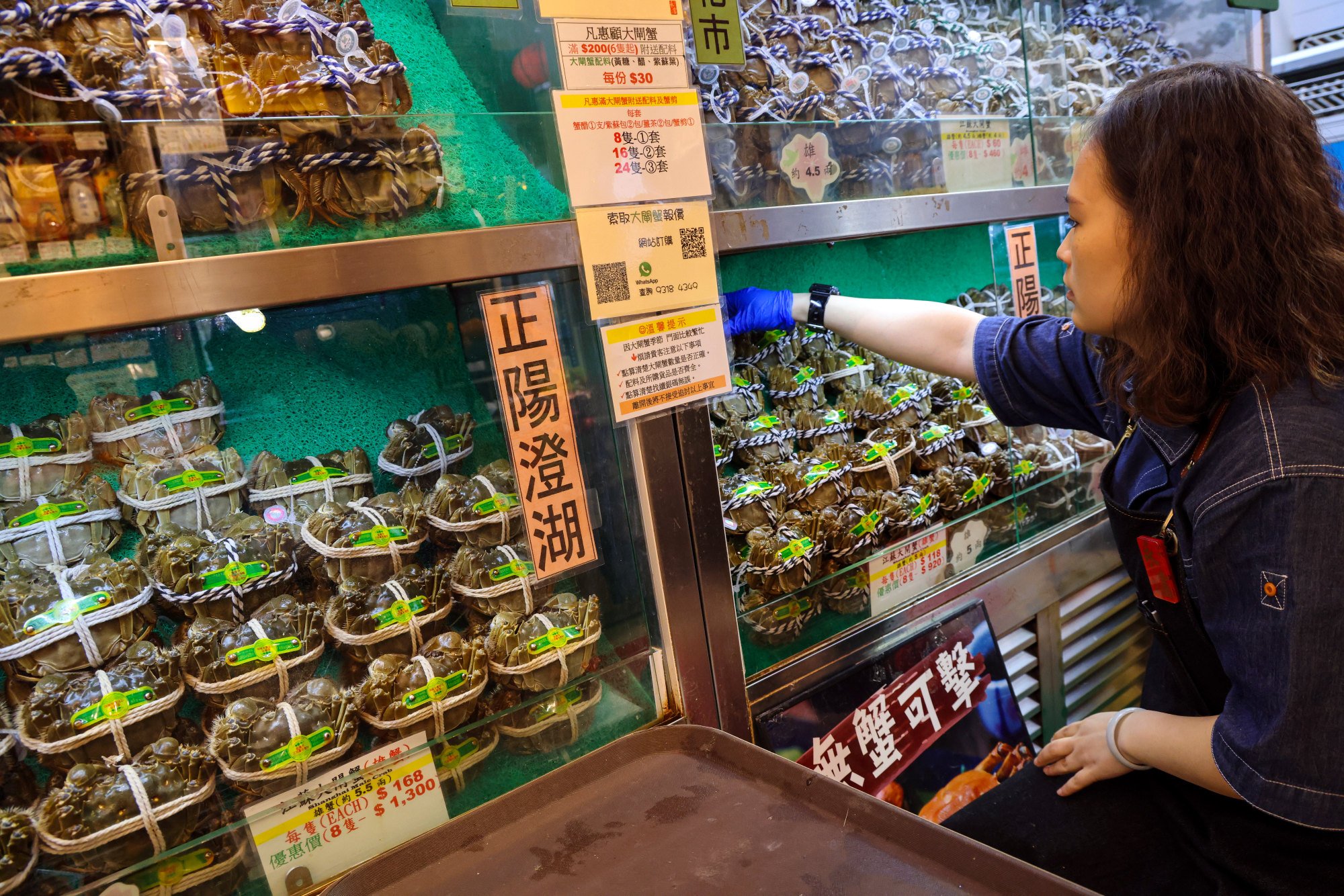The army of Hongkongers heading across the border for leisure spending and entertainment has eaten into the sales of hairy crab retailers in the city, who complain sales in the peak season for the delicacy have fallen by at least 30 per cent over last year.
Gary Tsao, owner of “Icrab.one” in the Causeway Bay shopping hub, has responded to the changing demand by removing one of his shop’s three fridges and he now operates on limited days too.
This year, he cut his crab imports from mainland China by 20 per cent, citing Hong Kong residents’ preference to purchase them in Shenzhen and the overall local spending downturn.
Do you have questions about the biggest topics and trends from around the world? Get the answers with SCMP Knowledge, our new platform of curated content with explainers, FAQs, analyses and infographics brought to you by our award-winning team.
“We now stock about two boxes weekly, compared with at least one box daily in previous years,” Tsao, a 10-year veteran of the business, said.
Each box usually contains 80 crabs, depending on their size.
The delicacy, known for its sweet flesh and creamy, buttery golden roe, is available only in the fall. The season begins anywhere from late September to early October and runs until November.

Tsao said business was down by 90 per cent compared with the same period last year. He attributed the drop to changing consumer habits and the emigration of former customers.
The trend of Hongkongers heading north to spend is being blamed for a spate of shop closures. The government said on Thursday the economy grew by 1.8 per cent in the third quarter, year on year, down from the 3.2 per cent recorded in the second quarter.
Although China’s economic slowdown has not notably affected import prices of the delicacy, recent adverse weather conditions had delayed the crabs’ growth to full size, Tsao said.
He prices his crabs at HK$130 (US$16.7) to HK$160 each, about HK$10 lower than last year.
Miss Hung, the owner of nearby Hung Kee, also reported reducing her orders by 30 per cent this year, while anticipating a similar decline in sales.
While unsettled weather on the mainland this year had resulted in smaller crabs overall, the ones being exported to Hong Kong remained of “good quality”, she said.
She was asking between HK$50 and HK$400 per crab, depending on its size, similar to last year.
Ronald Cheung, who manages a nearby crab shop, said he had slightly reduced his inventory this season and expected a 3 per cent drop in business.
“Mainland sales may be slower due to the economy, but this won’t significantly affect supplies to Hong Kong, which represents a small portion [of the national market],” Cheung said.
A crab enthusiast, 60-year-old Simon Tsui, who works in publishing, had already enjoyed the delicacy several times this season, both locally and in Shenzhen, where they were cheaper.
“They are good value for money,” he said.
According to Tsui, crabs in Shenzhen were priced at about one-third less than in Hong Kong and the taste was nearly the same.
He dined on hairy crabs at a Shenzhen restaurant several times last season and planned to return next month, adding he was likely to buy some from stores near a border checkpoint on the mainland side.
“I’m not too concerned about food safety when dining at that high-class restaurant, their quality should be better,” he said.
A crab lover born in Hong Kong and who had moved to Malaysia said she adored the delicacy “like crazy.” She usually spent HK$2,000 in a season on crabs and enjoyed them with her family at home.
When asked whether she would tighten her budget this year, she replied: “I won’t, because I have to eat them; I just can’t escape from them.”
Despite living in Malaysia for more than a decade, she continued to return to Hong Kong for the crabs, usually purchasing them in Causeway Bay.
She also had concerns about the quality of crabs across the border, saying: “They don’t feel safe. Things sold in Hong Kong require certifications, making them safer for your stomach.”
Most crabs imported into Hong Kong come from Jiangsu province, with Yangcheng Lake crabs considered premier quality. But these crabs rarely reach the city’s markets due to high demand on the mainland.
Recent claims by one shop that it sold Yangcheng Lake crabs were met with scepticism from retailers such as Tsao.
“Getting genuine Yangcheng Lake crabs now and here is really rare,” he said. “It’s a once-in-a-lifetime treat if you can taste them.”
More from South China Morning Post:
- Hongkongers nip over to mainland China to save on hairy crabs, with some sellers offering to deliver seasonal delicacy
- Customs arrests 6 Hongkongers for allegedly smuggling raw food worth HK$200,000
For the latest news from the South China Morning Post download our mobile app. Copyright 2024.





